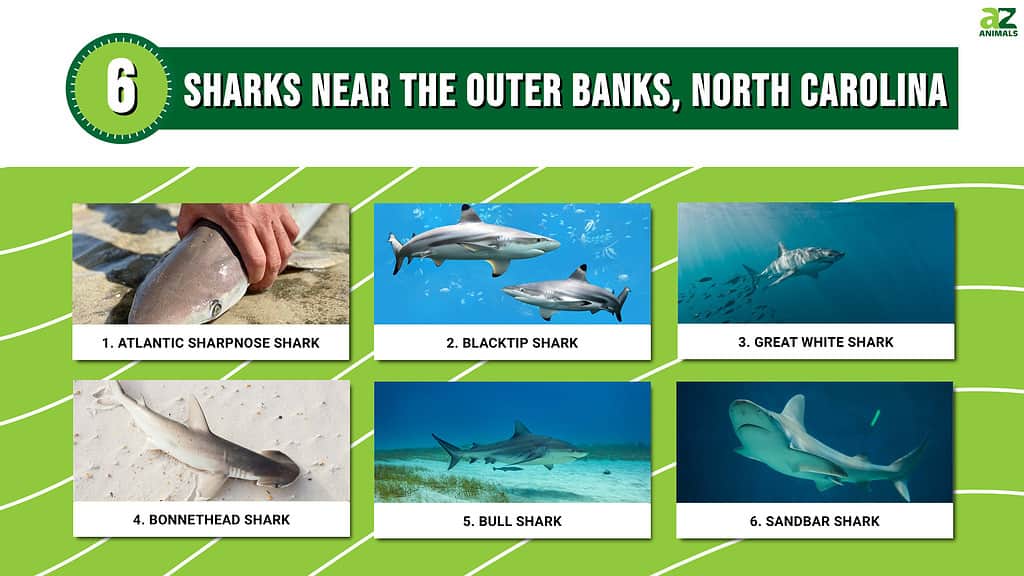
The Outer Banks are a strip of barrier islands off the coast of North Carolina. They are a popular spot for tourists to take in the natural beauty of the Southeast on pristine beaches. The beaches are steeped in history and contain quaint villages, picturesque lighthouses, and galloping wild horses.
But people also come here to surf and splash in the water. Many don’t realize that the North Carolina coast is a hot spot for sharks and other marine life. Discover six sharks near the Outer Banks, North Carolina, and where you might encounter them.
1. Atlantic Sharpnose Shark
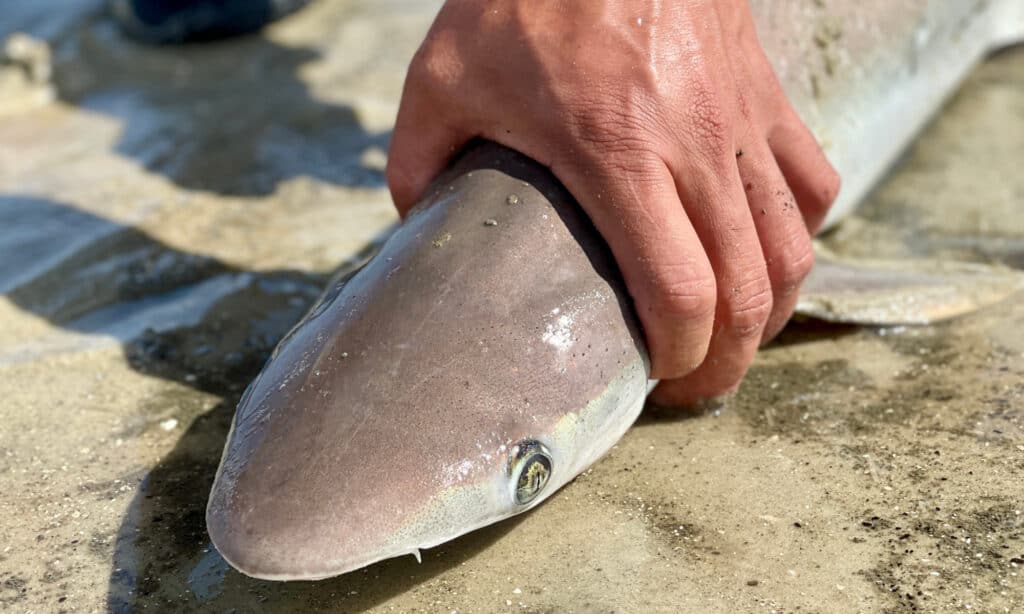
The Atlantic sharpnose shark is one of the most common sharks in the Outer Banks of North Carolina.
©Finley Del/Shutterstock.com
Atlantic sharpnose sharks are requiem sharks and among the most common in North Carolina’s sounds and estuaries. They typically inhabit subtropical waters of the Atlantic Ocean, and they are abundant in the area during summer and fall. Females swim to deeper waters after mating in the spring, then return to shore to give birth about 10 to 11 months later. Pup sharks are often numerous in the area.
Atlantic sharp nose sharks are small for sharks, with adults reaching no more than four feet in length. They have streamlined bodies, long, pointy snouts, and varying shades of gray with white undersides. You will often find these sharks close to the shore, coming in contact with humans more frequently. However, they don’t pose much of a threat due to their small size, but their bites can require stitches.
2. Blacktip Shark

Blacktip sharks are abundant in the Outer Banks area during summer and fall.
©Gino Santa Maria/Shutterstock.com
Also a species of requiem shark, the blacktip shark is one of the largest sharks to inhabit the Outer Banks. They are especially common during summer and fall. Blacktip sharks are common in coastal tropical and subtropical water across the world. They make their way to North Carolina ocean water in the late spring. Atlantic blacktips are known for leaping out of the water and spinning several times before splashing back into the ocean.
This shark has a streamlined body, pointed snout, and small eyes. They are gray or brown on the upper half and white on the lower half, with black tips on several fins. The average length of a blacktip is around six feet, but some can grow up to eight feet on occasion. Blacktip sharks swim closer to the shore and may attack when humans cross their territory, especially during feeding.
3. Great White Shark
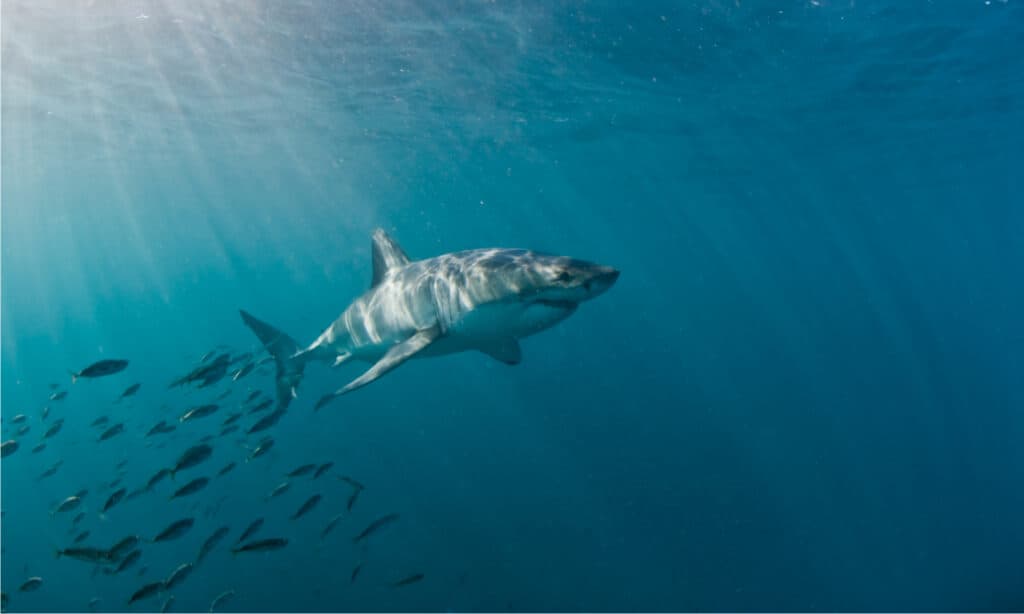
Great whites stay further offshore in North Carolina but occasionally find their way closer to the beach.
©Fiona Ayerst/Shutterstock.com
The great white is a large mackerel shark inhabiting all coastal ocean waters. It is well known for its blockbuster performances and its significant size and its intimidating appearance. Great whites can reach over 20 feet long and weigh up to 5,000 pounds. However, the majority are smaller. These apex predators feed on marine mammals and are responsible for more human attacks than any other shark.
Sightings of these mega sharks are rare in the Outer Banks, but they do happen. In North Carolina, great white sharks tend to stay way offshore but occasionally find their way near the beaches. The beach with the most shark attacks in North Carolina is Sunset Beach Pier in Brunswick County. Great whites travel long distances for migration and have a highly demanding diet. In fact, they eat up to three percent of their body weight every time they hunt.
4. Bonnethead Shark

Bonnethead sharks feed on the bottom of shallow water at the southern end of the Outer Banks sound.
©IrinaK/Shutterstock.com
The bonnethead shark, also known as the shovelhead shark, is part of the Hammerhead family. They inhabit shoreline areas in the North Atlantic and the Gulf of Mexico. As its name suggests, the bonnethead has a spade or shovel-shaped head and a grayish-brown body with a white underside. It varies from 2.5 feet to almost five feet, weighing between 13 and 20 pounds.
The bonnethead is the only omnivorous shark species and will eat crustaceans and seagrass. This species is rare in the Outer Banks but will sometimes make its way to the southern end of the sound. Here, it feeds in on the ocean bottom. Bonnethead sharks are not dangerous or aggressive and will typically leave people alone. Only one unprovoked attack was recorded for this species.
5. Bull Shark
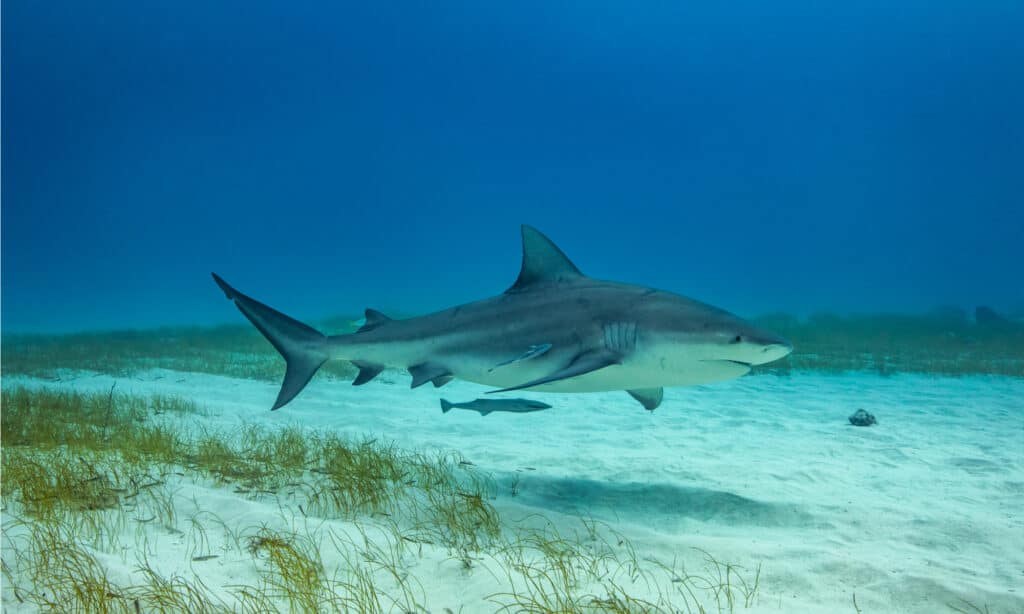
Bull sharks are the apex predators of the North Carolina Outer Banks.
©Carlos Grillo/Shutterstock.com
The bull shark is a requiem species found in warm, shallow water near the coastline and even in freshwater rivers. It’s aptly named for its stocky shape and wild, unpredictable behavior.
This species is known for being aggressive and responsible for many human attacks. This is most likely due to its propensity for being in highly populated areas. This sturdy shark is typically around eight feet long but commonly reaches 11 feet, weighing between 200 and 500 pounds. It has a broad, flat snout and a gray coloration with a white underside.
Bull sharks are the apex predators in the Outer Banks of North Carolina, with several sightings reported in multiple areas. These sharks are hostile, taking bites out of resident dolphins and messing with fishermen’s hooks. You should treat these animals with caution and steer clear.
6. Sandbar Shark
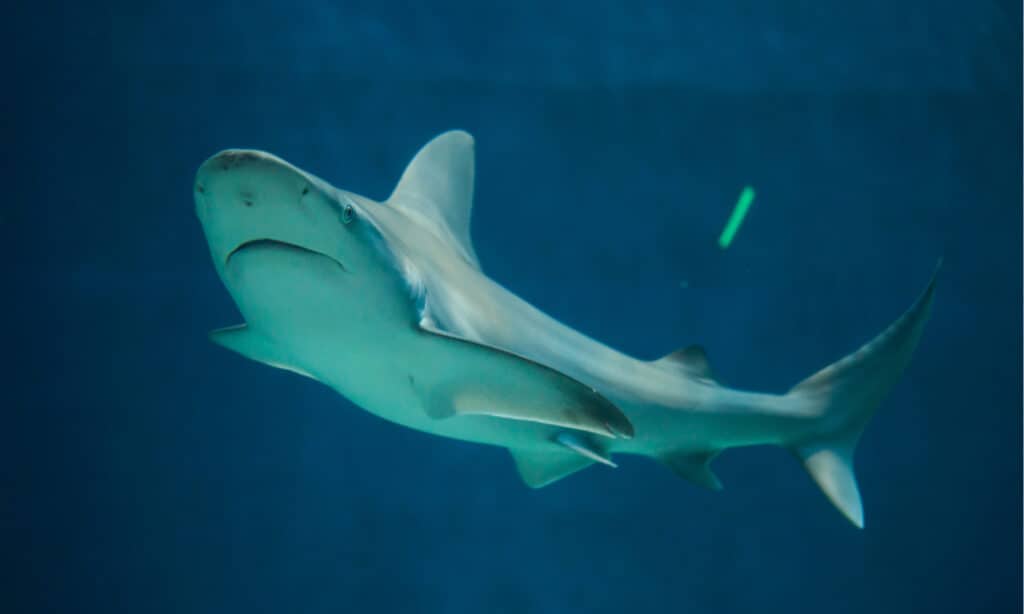
The sandbar shark is one of the most common big sharks in North Carolina waters.
©Vladimir Wrangel/Shutterstock.com
The sandbar shark is of the requiem species and is closely related to the bull shark, but it is distinguishable by its very high first dorsal fin. Sandbar sharks have short, rounded snouts and uneven teeth. Their color varies from blue to brown to gray with pale undersides, and they can reach over 8 feet in length.
Sandbar sharks are among the most common big sharks in North Carolina waters, and you can find them year-round, especially in late summer through fall. They prefer shallow coastal waters like sandbars, estuaries, and bays. While they do not account for many human attacks, you should still take caution. They are large fish that like to stay near the shore, but they prefer small prey like crabs, shrimp, and snapper.
Animals That Live Near the Outer Banks, North Carolina
The Outer Banks of North Carolina is a unique and diverse ecosystem that is home to a wide variety of animals.
From marine mammals to birds and reptiles, the area is rich in biodiversity and offers a glimpse into the natural world of the region:
- Bottlenose dolphins: One of the most common animals found in the waters surrounding the Outer Banks are bottlenose dolphins. These playful and intelligent mammals are frequently spotted swimming near the shoreline, and they are a popular attraction for visitors to the area.
- Sea turtles: The beaches of the Outer Banks are a nesting ground for several species of sea turtles, including loggerhead, green, and Kemp’s ridley turtles. These ancient creatures return to the same beaches each year to lay their eggs, and visitors to the area can witness this incredible natural spectacle during the nesting season.
- Seabirds: The Outer Banks is a haven for a variety of seabirds, including pelicans, gulls, terns, and sandpipers. These birds can be seen soaring over the ocean, perched on rocks and jetties, and scavenging for food on the beaches.
- Alligators: Although alligators are not native to the Outer Banks, they have been spotted in the area in recent years. These large reptiles are often found in freshwater ponds and canals, and visitors to the area should be cautious when exploring these habitats.
- Wild horses: Perhaps the most iconic animals of the Outer Banks are the wild horses that roam the beaches and barrier islands. These horses are believed to be descendants of Spanish mustangs that were brought to the area by early explorers, and they have adapted to the harsh coastal environment to become a unique and beloved part of the local ecosystem.
Overall, the animals that live near the Outer Banks of North Carolina are a testament to the incredible diversity and resilience of the natural world.
Summary Of The 6 Sharks Near the Outer Banks, North Carolina
| Rank | Shark |
|---|---|
| 1 | Atlantic Sharpnose Shark |
| 2 | Blacktip Shark |
| 3 | Great White Shark |
| 4 | Bonnethead Shark |
| 5 | Bull Shark |
| 6 | Sandbar Shark |
The photo featured at the top of this post is © Havoc/Shutterstock.com
Thank you for reading! Have some feedback for us? Contact the AZ Animals editorial team.






